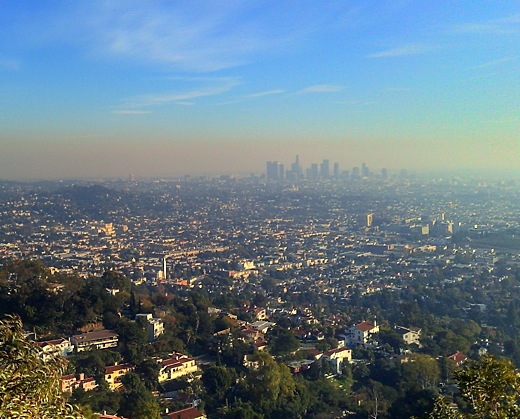SUBHEAD: The presence of higher levels of particulates are thought to be the primary drivers of climate change today.
By Stephen Messenger on 14 Nove3mber 2011 for TreeHugger -
(http://www.treehugger.com/climate-change/new-study-links-air-pollution-extreme-weather.html)

Image above: Smog filled skyline of Los Angeles, California. From (http://www.city-data.com/forum/city-vs-city/693001-skyline-competition-san-francisco-vs-los.html).
The harmful effects of air pollution on the human body are well documented, from causing brain damage to increasing the risk of heart attacks, but it turns out that it can put people under the weather in more ways than one. According to a new study from University of Maryland researchers, higher levels of airborne particulates has been linked to more intense weather manifesting as flooding and drought. The findings are the first of their kind to indicate that air pollution doesn't merely dirty the sky, it can actually change the climate too.
The results of the study, which appeared in the journal Nature Geoscience today, are considered an important revelation towards managing the increasingly taxed water resources throughout the world. Scientists have suspected that pollution from airborne dust and soot play a role in cloud development, but a recent pairing of observed weather data along with computer modeling confirms it.
“We have known for a long time that aerosols impact both the heating and phase changes [such as condensing and freezing] of clouds, and that they can either inhibit or intensify clouds and precipitation,” Russell Dickerson, an atmospheric scientist at the University of Maryland, tells The Epoch Times.
“What we have not been able to determine until now is the net effect. This study shows that fine particulate matter, mostly from air pollution, impedes gentle rains while exacerbating severe storms. It adds urgency to the need to control sulfur, nitrogen and hydrocarbon emissions.”
Researchers say that one of the main contributors to aerosols in the atmosphere are emissions from gas-powered motor vehicles, coal-burning power plants, and forest fires. Along with the greenhouse effect worsened by such emissions, the presence of higher levels of particulates are thought to be the primary drivers of climate change today.
.
By Stephen Messenger on 14 Nove3mber 2011 for TreeHugger -
(http://www.treehugger.com/climate-change/new-study-links-air-pollution-extreme-weather.html)

Image above: Smog filled skyline of Los Angeles, California. From (http://www.city-data.com/forum/city-vs-city/693001-skyline-competition-san-francisco-vs-los.html).
The harmful effects of air pollution on the human body are well documented, from causing brain damage to increasing the risk of heart attacks, but it turns out that it can put people under the weather in more ways than one. According to a new study from University of Maryland researchers, higher levels of airborne particulates has been linked to more intense weather manifesting as flooding and drought. The findings are the first of their kind to indicate that air pollution doesn't merely dirty the sky, it can actually change the climate too.
The results of the study, which appeared in the journal Nature Geoscience today, are considered an important revelation towards managing the increasingly taxed water resources throughout the world. Scientists have suspected that pollution from airborne dust and soot play a role in cloud development, but a recent pairing of observed weather data along with computer modeling confirms it.
“We have known for a long time that aerosols impact both the heating and phase changes [such as condensing and freezing] of clouds, and that they can either inhibit or intensify clouds and precipitation,” Russell Dickerson, an atmospheric scientist at the University of Maryland, tells The Epoch Times.
“What we have not been able to determine until now is the net effect. This study shows that fine particulate matter, mostly from air pollution, impedes gentle rains while exacerbating severe storms. It adds urgency to the need to control sulfur, nitrogen and hydrocarbon emissions.”
Researchers say that one of the main contributors to aerosols in the atmosphere are emissions from gas-powered motor vehicles, coal-burning power plants, and forest fires. Along with the greenhouse effect worsened by such emissions, the presence of higher levels of particulates are thought to be the primary drivers of climate change today.
.
No comments :
Post a Comment